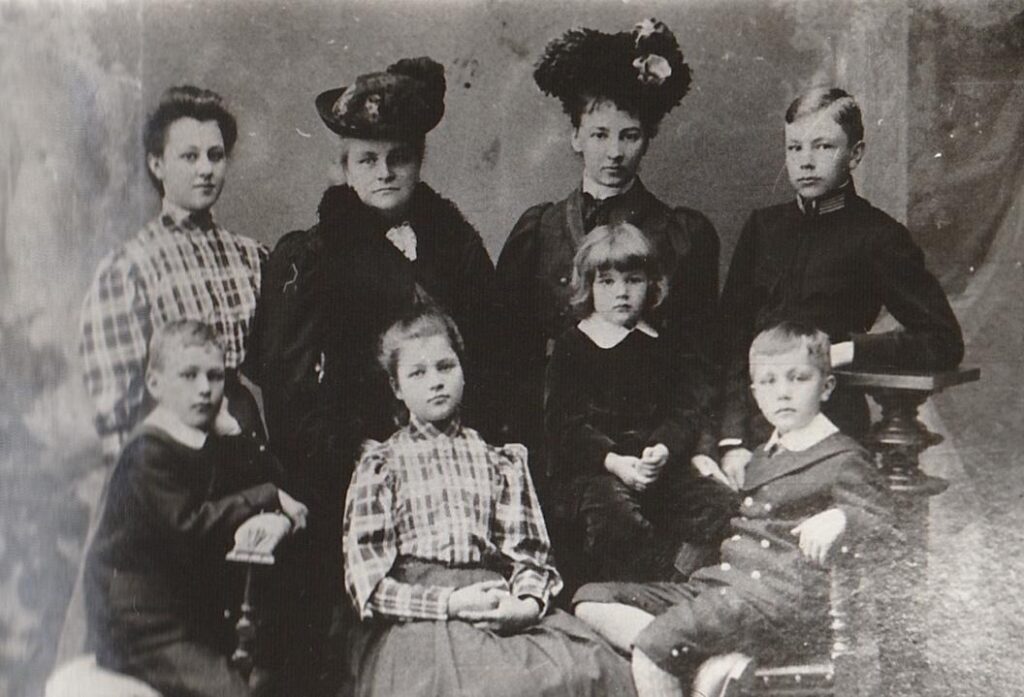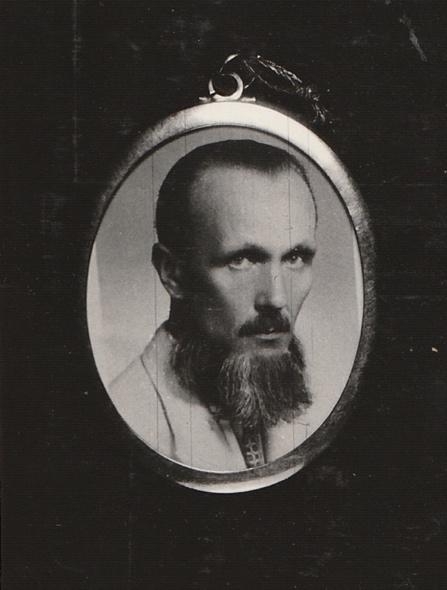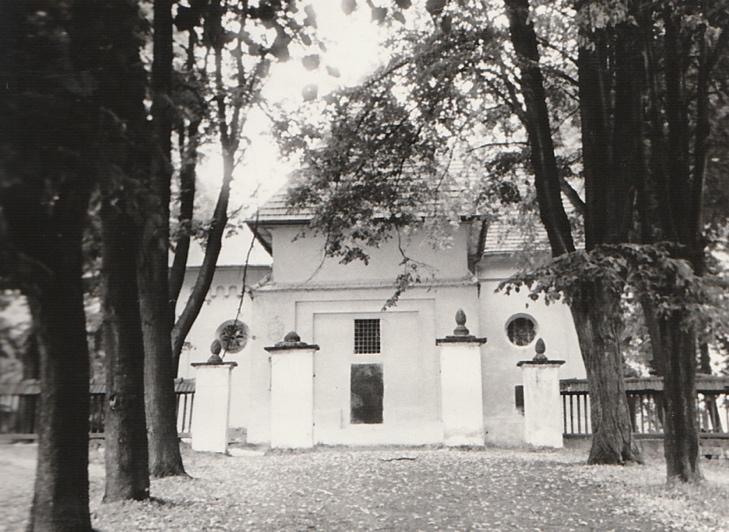TYTUS DUNIN ZE SKRZYNNA
Titus Dunin (1819-1860), the son of Ludwik Dunin and Konstancja de Gorki Gorczyńska, was the owner of Głębowice, Gierałtowiczki, and Chocznia. In 1844, he married Albina, countess Bobrowska.
After Tytus's death, his widow, Albina Dunin, fulfilling her late husband's will, commissioned the construction of a beautiful chapel connected to the church under the patronage of Our Lady of the Scapular in Głębowice (kościół pw. Matki Bożej Szkaplerznej w Głębowicach). Beneath it lies the tomb of the Dunin family.

Tytus Dunin of Skrzynno

Albina, countess Bobrowska, wife of Tytus Dunin
STANISŁAW DUNIN OF SKRZYNNO
Stanisław Dunin (1848-1903), the son of Tytus Dunin and Albina of the Bobrowski family, was the owner of Głębowice, Gierałtowiczki, Chocznia, Kopytówka, and Brzezinka. He was a well-educated man, having completed his studies at the Higher Agricultural School in Vienna. He founded the Agricultural Society in Wadowice, which initiated the activities of the Wadowice Agricultural Company as a step in the hierarchy of the Agricultural Circle and the Małopolska (Lesser Poland) Agricultural Society. He served as a delegate of the Land Credit Society in Lviv.
Stanisław married Maria of the Ursyn-Pruszyński family, of the Rawicz coat of arms. They had seven children: Felicja (1889-1890), Albina, Tytus, Olga, Józef Stanisław, Ludwik and Piotr Jerzy.

Stanisław Dunin

Stanisław Dunin with his wife Maria of the Ursyn-Pruszyński family.
Stanisław and Maria Dunin maintained a traditional Catholic and Polish household. They were part of the landed elite and had connections with many noble families.
Stanisław was deeply involved in local community efforts. He donated the former manor inn to support the school and was most likely the founder of the Głębowice Agricultural Circle in 1896. His agricultural estate set a model example nationwide in various aspects of production, breeding, and agricultural industry.

The Dunin family, 1905. From left: Albina Dunin, Maria Dunin born Ursyn-Pruszyńska, Celina Bzowska born Dębicka, Tytus Dunin. Sitting from left: Józef Stanisław Dunin, Olga Dunin, Piotr Jerzy Dunin and Ludwik Dunin.

The Dunin brothers: Ludwik is standing, Józef Stanisław is sitting and has Piotr Jerzy on his lap.
Stanisław Dunin passed away at the age of 55 after a severe illness in Tyrolean Gleichenberg. His remains were transported to Głębowice and laid to rest in the family tomb beneath the church chapel.
Stanisław Dunin's funeral became a manifestation of respect for the deceased, even reported by the Kraków-based newspaper Czas. A crowd of relatives, neighbors, and clergy gathered at the Zator train station.
Parish priest Józef Nieć greeted Stanisław's remains with a moving eulogy. The gathered locals formed a procession for the highly respected and beloved landowner. During the mourning speeches, the deceased's contributions to civil service were highlighted, but above all, his nobility was remembered, emphasizing that he was a true father and brother to his people.
ALBINA DUNIN OF SKRZYNNO
(1890-1972), the first daughter of Stanisław and Maria, married Izasław Sroczyński of the Nowina coat of arms. They had four children: daughter Felicja and three sons: Andrzej, Stanisław and Michał.
Andrzej, a lawyer from Łódź, was severely injured and lost an eye in September 1939. Stanisław graduated from the Technical University of Gdańsk, but in 1944, fighting in the ranks of the Home Army (AK), he perished in the Warsaw Uprising. Michał, a lieutenant of Uhlans, fought in 1939 and later with the Home Army (AK), participating in battles in Warsaw.
OLGA DUNIN OF SKRZYNNO
(1893-1959), the second daughter of Stanisław and Maria, married Stanisław Dzierżykraj-Morawski of the Drogosław (Nałęcz) coat of arms.

Olga Dunin. Painting by Pochalanka.
TYTUS DUNIN OF SKRZYNNO
Tytus (1892-1939), the first son of Stanisław and Maria, owner of Gierałtowiczki, a cavalry captain of the 8th Uhlan Regiment of Prince Józef Poniatowski, member of the County Council in Oświęcim. In 1919, he married Maria countess Romer, of the Jelita coat of arms, and they had four children.

Tytus Dunin and his wife Maria countess Romer.

Tytus Dunin

Marshal Józef Piłsudski on a horse named Kasztanka. Kasztanka was a riding mare of Maria Dunin born Romer, originating from the Eustachy count Romer's stable in Czaple Małe. Donated to the Legions in 1914.
10th September 1939, Cavalry Captain Tytus Dunin, probably posthumously promoted to the rank of Major, along with Ensign Konstanty Ostrowski, heroically perished while attempting to destroy a German tank and defending a bridge over the Wisłok river in Tryńcza near Przeworsk. The Germans, who were firing at them, believed that they were facing an entire military unit, so they were astonished that only two officers engaged them in combat. They arranged a solemn funeral, and German soldiers fired a ceremonial salute over the makeshift graves of Dunin and Ostrowski. The local community always reverently cares for the memory of these heroes.

The grave of Major Tytus Dunin and Corporal Ensign Konstanty Ostrowski at the cemetery in Tryńcza.
Dulce et decorum est pro Patria Mori

The memorial plaque at the bridge in Tryńcza.
Children of Tytus and Maria Dunin
Stanisław (1919-1987) graduated from high school in Kraków in 1937, after which he began studying at Jagiellonian University. He fought in the Polish Armed Forces in the West. After the German attack on Poland in 1939, he crossed the green border in the Tatra Mountains in winter and went to France. In France, he volunteered for the Polish Army and served in the 2nd Division. During the battles, he was awarded the Croix de Guerre avec Etoile de Bronze. Ordere No. 2190/C for exceptional courage, especially while conducting intelligence deep behind enemy lines near Montrellard, with two colleagues.
After the fall of France, he rode on horseback to Switzerland, where he continued studying law at the University of Freiburg. In 1951, he married Joanna Tyszkiewicz, and they settled in London. They have three children: Karolina, Stefan and Stanisław.
In 1962, he was made a Knight of the Order of Malta De Onore et Devotione Ass. Polacca.

Stanisław Dunin
Teresa (1920-1944), called Baśka, was a soldier in the Home Army (AK) and met a heroic death during the Warsaw Uprising on September 2, 1944. As a medic in the Radosław unit, she refused to leave the wounded during the bombing of the hospital in the Old Town, stayed with them, and perished under the rubble along with them. She was posthumously awarded the Cross of Valor.

Teresa Dunin called Baśka.
Dulce et decorum est pro Patria Mori
Elżbieta (1922-1991) was awarded the Cross of Valor for her activities in Warsaw in 1944.
Ludwik (1924-1944), alias Włast, was a soldier of the 7th Lublin Uhlans Regiment Jeleń in the Home Army (AK). He died a heroic death in Sadyba during the Warsaw Uprising on September 2, 1944. Undertaking an impossible task with his comrades, he bid farewell to his mother, gave her his signet ring, and went to certain death. After his death, he was awarded the Cross of Valor and the Commemorative Badge of the 7th Lublin Uhlans Regiment named after Gen. K. Sosnkowski.

Ludwik Dunin called Włast.

Ludwik Dunin called Włast.

Ludwik Dunin was buried with his fallen comrades in the cemetery in Wilanów. Warsaw, Poland.
At Powązki Cemetery, there is a plaque of the 7th Lublin Uhlans Regiment Jeleń of the Home Army (AK) with the names of the fallen soldiers.
Dulce et decorum est pro Patria Mori
JÓZEF STANISŁAW DUNIN OF SKRZYNNO
Józef Stanisław (1896-1980), the second son of Stanisław and Maria, was the owner of Głębowice.

Józef Stanisław Dunin
LUDWIK DUNIN OF SKRZYNNO
Ludwik (1898-1949), the third son of Stanisław and Maria, was a co-owner of Kopytówka (with his brother Piotr Jerzy) and the owner of Brzezinka. He served as a lieutenant in the Cavalry Artillery and was a delegate of the Land Credit Society in Lviv.

Ludwik Dunin
Manor House in Kopytówka

The estate of Kopytówka from a bird's eye view. The photo was taken by Piotr Jerzy Dunin in 1937.

Kopytówka, 1966r.

Kopytówka, 1966r.

Kopytówka, 2020r.
PIOTR JERZY DUNIN OF SKRZYNNO
Piotr Jerzy (1901-1942), the fourth and youngest son of Stanisław and Maria. He was a co-owner of Kopytówka (with his brother Ludwik). Piotr Jerzy served as a pilot in the RAF and a member of the Polish Armed Forces in the 309 Squadron. In 1926, he married Honorata Skibniewska of the Ślepowron coat of arms.
Mobilized in August 1939, he took part in the air defense of Poland as the commander of the 3rd platoon of liaison aircraft. After the September defeat, he made his way to France, where he served in the Polish Air Base in Bron near Lyon. Following the capitulation of France, he arrived in England, where he was assigned to the 309 Squadron in Dumfries, Scotland.

Piotr Jerzy Dunin, 1930r.
On February 25, 1942, as the deputy squadron commander, he participated in a training flight with two other aircraft. Unfortunately, he did not pull out of the dive and crashed into a tree in the village of Dunino. Examination of the aircraft wreckage revealed that the tragedy was caused by damage to the control system.
Lieutenant Piotr Dunin, known in the squadron as Dziadzio (Grandpa), was a widely liked and respected commander. He ran the officers' mess, where he was known as a good organizer of social life. He was buried in the cemetery at St. Andrews in Scotland.
Wacław Król, a Polish aviation ace, recounted an interesting story:
It was intriguing that the airfield was situated on the estate fields of Mr. Dunin, a Polish insurgent from 1830, who emigrated from Poland after the fall of the November Uprising and purchased an estate in Scotland near St. Andrews. The estate was named Dunino, hence the name of the airfield. Strangely enough, among the flying personnel was Lt. Pilot Piotr Jerzy Dunin, related to the former insurgent. Unfortunately, fate decreed that Lt. Pilot Dunin, during a training flight with observer Lt. Jerzy Homan on February 25, 1942, in Lysander no. V-9472 for a mission to collaborate with the military, perished in an aircraft crash due to a plane malfunction. Lt. Observer Homan also lost his life in the accident.

The wedding of Piotr Jerzy Dunin and Honorata Ślepowron Skibniewska, Maćkowice 1926.

The grave of Piotr Jerzy in Scotland.

The four Dunin brothers: from left: Tytus on horse Perla, Ludwik on Zagłoba, Józef Stanisław on Kasztanka, and 12-year-old Piotr Jerzy on Lauda. Grodkowice, 1913.

The Dunin brothers before hunting at Kopytówka in 1917.
From left standing: Piotr Jerzy, Józef Stanisław and Tytus.
On the right side: mother Maria Dunin born Ursyn-Pruszyński and sisters Albina and Olga, along with Izasław Sroczyński.
THE CHURCH UNDER PATRONAGE OF OUR LADY OF THE SCAPULAR IN GŁĘBOWICE (Kościół pw. Matki Bożej Szkaplerznej w Głębowicach)
The historic, timber-framed and brick church in Głębowice from 1518 has undergone several transformations. In 1861, at the request of Albina countess of Bobrowski Dunin, a chapel was added dedicated to her late husband Tytus. The chapel, connected to the church on the southern side, was equipped with a neo-Baroque altar in black color imitating Dębnicki marble, popular during the Baroque period. The chapel also houses the Dunin family pew, adorned with the family crest, and below the chapel lies the Dunin family tomb. Embedded in the northeast wall of the church are tombstones of Ludwik and Teodor Dunin.

The Lime Tree Alley (now Grunwaldzka Alley), leading to the church under patronage of Our Lady of the Scapular in Głębowice. The church is located on the Wooden Architecture Trail of the Małopolska (Lesser Poland) Voivodeship.

The northeastern wall with the tombstones of Ludwik and Teodor Dunin.

The tombstones of Ludwik and Teodor Dunin, embedded in the wall of the church in Głębowice.

The neo-Baroque altar in the Chapel of St. Tytus.

The Dunin family's benefactors' pew with the Swan coat of arms in the Chapel of St. Tytus.

The plaque at the church in Głębowice with biographies of representatives from three successive generations of the Dunin family: Tytus, Stanisław and Józef Stanisław.

